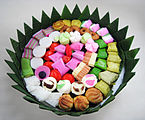Kue talam
 Minang version of coconut sugar flavoured kue talam with white-brown colour, cut in rectangular form | |
| Alternative names | Talam, kuih talam |
|---|---|
| Type | Steamed sweet coconut layered cake |
| Course | Snack |
| Place of origin | Indonesia |
| Region or state | Nationwide |
| Serving temperature | Room temperature |
| Main ingredients | Rice flour, coconut milk, sugar |
Kue talam is an Indonesian kue or traditional steamed snack made of a rice flour, coconut milk and other ingredients in a mold pan called talam which means "tray" in Indonesian.[1] The cake mold used to create kue talam are either larger rectangular aluminium tray or smaller singular cups made from ceramics, aluminium, melamine or plastic.[2]
Kue talam and its variations are commonly found in various Indonesian regional cuisine traditions; from Betawi, Minang, Malay, Batak, to Sundanese and Javanese. Kue talam was introduced by the Sino-Burmese to Lower Myanmar, where it is known as kway talan (ကွေတာလန်း).[3]
Kue talam usually has two layers; the top one is white made from savoury creamy coconut milk, while the bottom one is coloured according to each variant's recipe. The green pandan flavour, the yellow yam and the brown coconut sugar flavours are the most common one.
Ingredients
The basic ingredients of kue talam are rice flour, coconut milk, granulated sugar, salt, and pandan leaves.[4] Other ingredients might be included to create the lower coloured part.
The top one is white and made simply using more coconut milk, rice flour, sugar and salt, and usually tastes savoury, mild sweet with softer creamy consistency. The bottom one is a little bit firmer and has colours according to added ingredients. The bottom coloured layer are poured first into the mold. After being half cooked being steamed for some times, the white layer is added on top and steamed further.[5]
The mold being used traditionally is rectangular aluminium tray mold, hence the name talam (tray), thus the cake is required to be cut into rectangular or square shape prior of serving. Today however, the singular small cups akin to chawan (Chinese teacup) are often used as mold; either made from ceramics, aluminium, plastic or melamine.
Variations

Sweet
Kue talam normally tastes sweet and consists of two layers, white top and coloured bottom. Kue talam could be made in various flavours which contributes to the colours of the bottom part, they are:
- Green: the green bottom kue talam is using suji or the green juice acquired from pandan leaf.[4]
- Brown: the brown colour is acquired from gula merah or gula jawa (coconut sugar).[6]
- Yellow: the yellow bottom is acquired from red or yellow sweet potato,[2] pumpkin or corn.
- Purple: the purple colour is acquired from ubi ungu or purple yam or taro.[7]
Savoury
Most of kue talam tastes sweet, however there is also a salty and savoury variants that uses ebi or dried shrimp for flavour, which is called talam udang or "shrimp talam" in Betawi cuisine of Jakarta.[8]
See also
References
- ^ "Google Translate". translate.google.com. Retrieved 2020-06-06.
- ^ a b Inc, Tastemade. "Kue Talam ~ Resep". Tastemade (in Indonesian). Retrieved 2020-06-07.
{{cite web}}:|last=has generic name (help) - ^ "ခေါက်ဆွဲစားတဲ့ မြန်မာများ". BBC News မြန်မာ (in Burmese). Retrieved 2021-01-14.
- ^ a b "Kue Talam Tepung Beras Pandan Lembut Istimewa - Resep". ResepKoki (in Indonesian). Retrieved 2020-06-06.
- ^ Times, I. D. N.; Cahya, Putriana. "Resep Bikin Kue Talam Pandan yang Sederhana, Cocok buat Acara Spesial". IDN Times (in Indonesian). Retrieved 2020-06-07.
- ^ "Resep Kue Talam Gula Merah oleh Rini Julia". Cookpad (in Indonesian). Retrieved 2020-06-07.
- ^ "Resep Kue Talam Ubi Ungu". Endeus TV (in Indonesian). Retrieved 2020-06-07.
- ^ Purwanti, Selvi (2016-01-13). "Talam Udang Khas Betawi yang Menggugah Selera". MerahPutih. Retrieved 2020-06-07.

